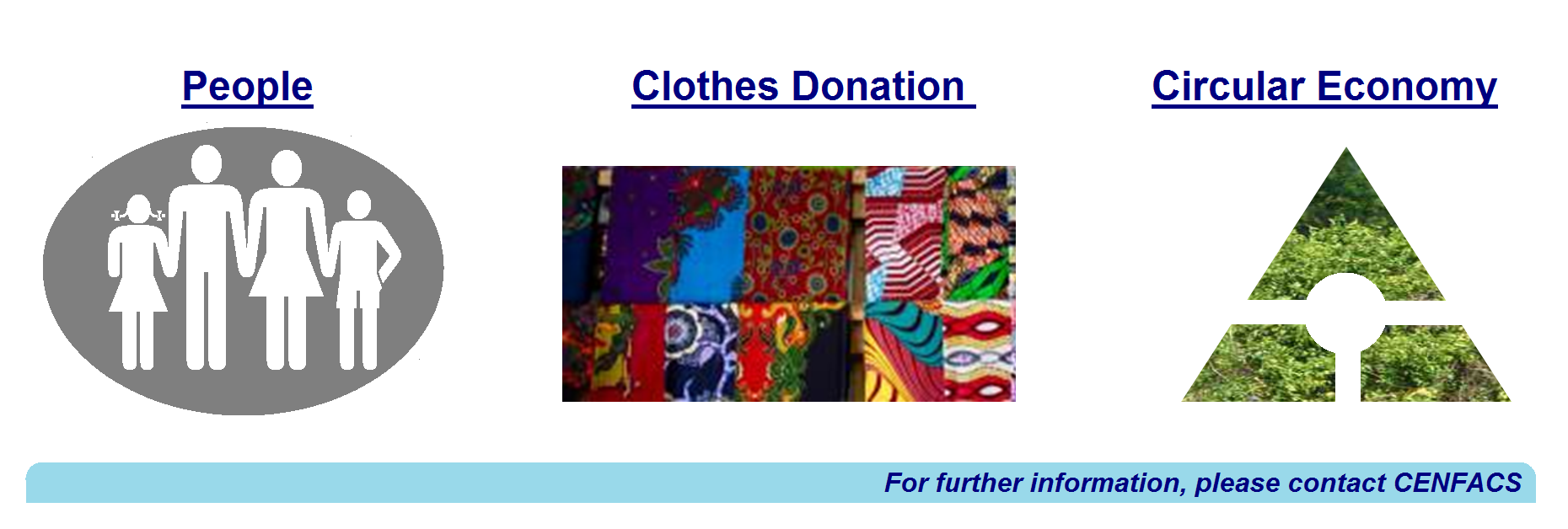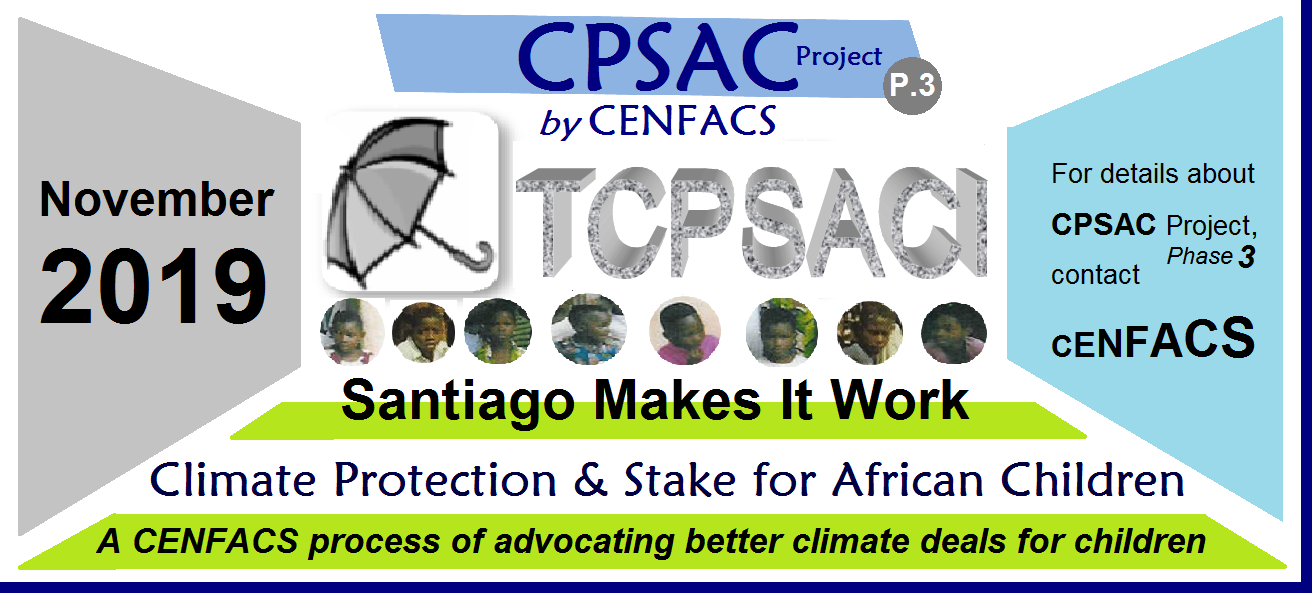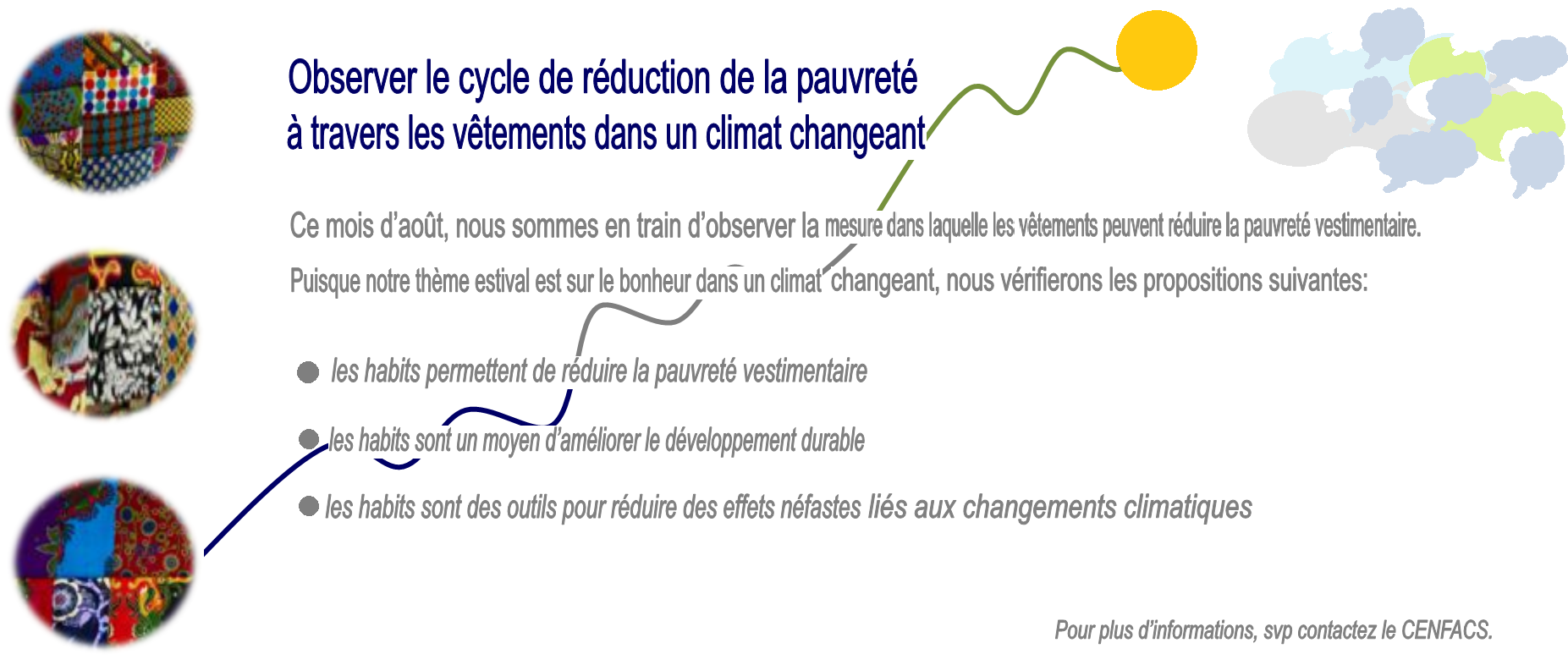Welcome to CENFACS’ Online Diary!
21 August 2019
Post No. 105
The Week’s Contents
• TRENDING in Poverty Relief in a Changing Climate: Clothes Donation as Contributor to the Circular Economy
• “Quadranscentennial” (Q) Challenge with Virtual 4 km RUN to Reduce Poverty in a Changing Climate
• Summer Volunteering TRIPS to the Need in a Changing Climate
… and much more!
Key Messages
Our Summer Triple Pack made of Track, Trip and Trending continues this week. The key message we would like to get across this Triple Pack is to try to help reduce poverty by undertaking any of these three activities: running, visiting projects and analysing trends.
~ Trending in Poverty Reduction in a Changing Climate
In Focus from 19/08/2019: Clothes donation as contributor to the circular economy
Our serial trend in poverty reduction in a changing climate is now in its third week. We are following the direction of poverty reduction by looking at the contribution of clothes donation to the circular economy.
In this follow-up process, we are as well considering the adverse effects of climate change through what we call a changing climate. Climate change can impact on the donation of clothes made and the contribution of clothes to the circular economy.
More on this element of our Triple Pack, the trend element, can be found in the Main Developments section of this post.
~ Q Challenge with Virtual 4 km Run to Reduce Poverty in a Changing Climate
CENFACS’ Q Challenge with Virtual 4Km Run continues this week. You can virtually run or walk from any location you choose. You can run, jog, or walk on the road, on the trail, on the treadmill, at the gym or on the track (or even at another race). You can run your own race, at your own pace, and time it yourself.
Virtual Run broadens the scope of our physical activity project of running to reduce poverty. It brings into our project the running activities carried out in the virtual world or digital and computer worlds or other worlds; activities that may contribute to our efforts in helping to reduce poverty.
Our focus on physical aspect of the Run project still remains the same including its key spirit, which is of undertaking a basic physical activity of running to help reduce poverty. However, in real world there are people who would like to do things physically, but for various reasons they may not be able to do so. Because of that, there is an alternative to do it virtually with CENFACS.
All we are asking in this Q Challenge is to complete 4 Km Run wherever you want to do them. Before doing it, please let CENFACS know.
For further details and to inform us about your virtual Run, refer to the notes under the Main Development section of this post.
~ Summer TRIPS to volunteer for needy people and communities
These are the kinds of experiences we expect people to do over the Summer period especially for those who want to spend their Summer time differently, particularly but not exclusively, by doing something about poverty. These experiences include field service activities carried out when visiting a project and which people can report their findings.
We recommend this type of experiences under our volunteering scheme known as All in Development Volunteers Scheme(AiDVS). Under CENFACS’ AiDV Scheme, one can take seasonal opportunities like of Summer to volunteer or do some internship on poverty relief and sustainable development.
Where the person decides to go far away to visit needy communities or volunteer to our Africa-based projects, CENFACS would facilitate and liaise with its Africa-based Sister Organisations where the projects are based to smooth the volunteering process or visits to the projects under mutually agreed arrangements and conditions.
For details about AiDVS, contact CENFACS. If you have visited or volunteered for projects recently and would like to share with us your experience, please contact us as well.
Extra Messages
~ “Quandranscentennial” (Q) Challenge with 25 Trends to Identify
Our investigative work to find the 25 trends of CENFACS continues this week through the Q Challenge; trends that provide the cartography of CENFACS’ poverty reduction work.
All we are asking in this Q Challenge is to complete to search and find 25 Trends that made CENFACS an organisation it is today. To take part in this CENEFACS Q Challenge, please contact CENFACS.
~ 2019 Climate Talks Follow-up with Taking Climate Protection and Stake for African Children at the Implementation level: Santiago Makes It Work
TCPSACI (Taking Climate Protection and Stake for African Children at the Implementation level) or Climate Protection and Stake for African Children (CPSAC) – Phase 3 has already started by our preparation to follow the Climate Talks to be held in Santiago (Chile) at the 25th session of the Conference of the Parties (COP 25) to the United Nations Framework Convention on Climate Change, which is expected to take place from 11 to 22 November 2019. Therefore, our next climate talks follow up is Santiago Makes It Work.
Santiago Makes It Work will look at how previously agreed measures will help to protect children especially when reporting and verifying emissions-cutting efforts.
Our position is explained by the fact that there is still a missing element which is stepping up targets on child protection in relation to cutting emissions.
One can hope that when the United Nations will meet in Santiago (Chile) in November 2019, this will be an opportunity to sort out the final elements of the Paris rule book and begin work on future emissions targets. In doing so, this will provide us some clarity about climate protection and stake for children.
TCPSACI or CPSAC – Phase 3 will also help us to prepare for the United Nations Climate Summit, which is scheduled for 23 September 2019.
As the agendas for COP25 and the UN Climate Summit will become clear, we shall release further information about our advocacy work on both events; work which includes TCPSACI or CPSAC – Phase 3 and the Follow up of the Climate Summit. In meantime, we are doing our preparation for these follow ups.
~ The Great Beasts Campaign
As the CITES (Convention on International Trade in Endangered Species) is currently evaluating regulations and species protection listings at its Summit in Geneva, we are resuming our campaign work to protect endangered species while keeping an eye on this Summit of the Sixth Mass Extinction.
We are doing it through the Great Beasts campaign (GBC) which extends of Big Cats campaign, cats being part of beasts. The GBC campaign aims at helping to protect endangered species such as African elephants, rhinoceros form extinction and exploitation. Although the GBC will last until the end of the CITES Summit (on 29/08/2019), it will not stop at this date. It will be resumed when we start our a la une (Autumn Leaves of Action for the Upkeep of the Nature in Existence) campaign this coming Autumn.
For further about the Great Beasts campaign, please contact CENFACS.
Main Developments
• Trending in Poverty Reduction in a Changing Climate
In Focus from 19/08/2019: Clothes donation as contributor to the circular economy
Clothes donation can have a good effect on the circular economy in many ways. However, what do we mean by circular economy?
~ What is a circular economy?
There are many circular economy schools of thought and definitions of circular economy. For the purpose of our development day, we are going to borrow the definition of circular economy from Ellen McArthur Foundation (1) which defines it in these following terms.
‘Looking beyond the current take-make-dispose extractive industrial model, a circular economy aims to redefine growth, focusing on positive society-wide benefits. It entails gradually decoupling economic activity from the consumption of finite resources, and designing waste out of the system. Underpinned by a transition to renewable energy sources, the circular model builds economic, natural, and social capital. It is based on three principles: a) Design out waste and pollution b) Keep products and materials in use c) Regenerate natural systems.’
This definition can be extended to family life and framework where those making this family use clothes or garment and textiles. Because our trend analysis is about people and among them women/mothers and children, let’s say where women or mothers and children are concerned; their involvement is in their handling or customizing the above three principles. In other words, in terms of family settings, we/they will be trying to think how they can design out waste and pollution, keep products and materials in use such as clothes, and help regenerate natural systems in their ways of dealing with natural resources.
Our preliminary interest is on these people and their adaption to the principles of the circular economic model and their transition to this model. Our main interest is on the contribution of clothes donation to the circular economy.
~ How clothes donation can contribute to the circular economy
The donation of clothes to good and deserving causes can contribute not only to the maintenance of these causes, but also to the circular economic model. There are many works that demonstrate this contributing or causal relationship between clothes donation and circular economy.
Here below are some of the contributions we found:
√ Prolong the life of clothes and materials made of
√ Reduce consumption of clothes
√ Help the circular textiles value chains
√ Promote circularity generally
√ Reduce the consumption of raw materials
√ Extend life cycles of clothes
√ Create revenue stream
√ Decrease waste
√ Maintain the value of fibre materials in circular
Etc
From the above, it is worthwhile mention the role of clothes donors, collectors and sorters in making this contribution happens. It is as well useful it insert the climate change dimension in the it affects the use clothes are stocked, used and recycled.
~ Clothes donation in a changing climate
In recent years, there has been continuous change in the climate with repeated high temperatures in many places of the world. This changing pattern of climate can affect the stock and use of clothes that one can keep to meet their clothing and climate needs.
This could mean destocking and donating unneeded clothes in a particular climate where one’s is located. It could also suggest the same clothes are needed for all weathers and seasons. Clothes can be sent to places that are mostly needed for a typical weather variation.
As stock costs to run, unneeded clothes can be donated to be recycled or reused in the current situation since the world is undergoing a situation of clothes supply is greater than their demand.
So, donating clothes can help to deal with clothes supply and demand in a changing climate.
To follow this trend with CENFACS or to discuss it, please contact CENFACS
(1) https://www.ellenmacarthurfoundation.org/circular-economy/concept (accessed on 09/11/2018)
• Q Challenge with Virtual 4 km Run to Reduce Poverty in a Changing Climate
CENFACS’ Run to Reduce Poverty is a physical activity project that aims at improving physical activity and mental health and well-being of the participants while helping to reduce poverty. However, for various reasons they are people who would like to support the relief efforts about poverty through run, but they may not be able to do it if the only way of doing it is through physical activity.
These people who may be experiencing handicap to do physical activity of running to help reduce poverty could include the following:
√ People/parents caring for very young children
√ Pregnant women
√ Elderly people
√ Disable people
√ Those who are not physically fit or mobile to run
√ Those who do not have opportunity to physically run
Under certain conditions and circumstances, we can also consider those who use outdoor and indoor fitness equipment to virtually run.
For these deprived-to-physically-run people, they can virtually run to help reduce poverty with CENFACS. If you are organising this kind of virtual activity or event, let us know. It is also better to advise us that the people participating in the virtual run are the physically deprived ones we listed above or they have a serious handicap prohibiting them to undertake any physical engagement.
Whether it is physical or virtual, Run to Reduce Poverty should be done by considering climate change factor. There is a need to take into account the changing pattern of climate which may or may not influence where one chooses to carry out their running activity.
Rising temperatures and sea levels, forest fires, disproportionate floods, repetitive droughts, cyclones etc remind us that everywhere we do our run activity, we should include climate factor. Climate change is not any more an exceptional phenomena, but it has become a common living pattern within the human system of living and working.
So, running to reduce poverty could be well done when a climate change dimension is part of it. It is in this way the runners of poverty reduction will be also aware of changing climate and be climate advocates. They can make sure that their run activity does not adversely the health of the environment (such as not to increase carbon foot print through running activity).
All we are asking in this Q Challenge is to complete 4 Km Run wherever you want to do them. Before doing it, please let CENFACS knows.
FOR ONLY £1, YOU CAN SUPPORT CENFACS AND CENFACS’ PROJECTS, JUST GO TO http://cenfacs.org.uk/supporting-us/
Thank you for visiting CENFACS website and reading this post.
Thank you as well to those who made or make comments about our weekly posts.
We look forward to receiving your regular visits and continuing support throughout 2019.
With many thanks.





